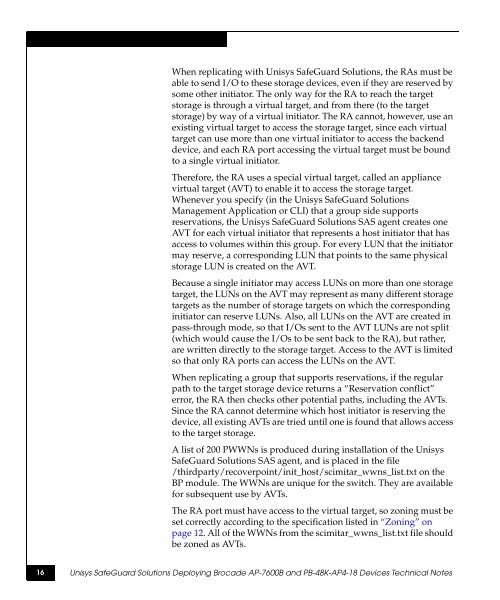SafeGuard Solutions Deploying Brocade AP-7600B and PB-48K ...
SafeGuard Solutions Deploying Brocade AP-7600B and PB-48K ...
SafeGuard Solutions Deploying Brocade AP-7600B and PB-48K ...
Create successful ePaper yourself
Turn your PDF publications into a flip-book with our unique Google optimized e-Paper software.
When replicating with Unisys <strong>SafeGuard</strong> <strong>Solutions</strong>, the RAs must be<br />
able to send I/O to these storage devices, even if they are reserved by<br />
some other initiator. The only way for the RA to reach the target<br />
storage is through a virtual target, <strong>and</strong> from there (to the target<br />
storage) by way of a virtual initiator. The RA cannot, however, use an<br />
existing virtual target to access the storage target, since each virtual<br />
target can use more than one virtual initiator to access the backend<br />
device, <strong>and</strong> each RA port accessing the virtual target must be bound<br />
to a single virtual initiator.<br />
Therefore, the RA uses a special virtual target, called an appliance<br />
virtual target (AVT) to enable it to access the storage target.<br />
Whenever you specify (in the Unisys <strong>SafeGuard</strong> <strong>Solutions</strong><br />
Management Application or CLI) that a group side supports<br />
reservations, the Unisys <strong>SafeGuard</strong> <strong>Solutions</strong> SAS agent creates one<br />
AVT for each virtual initiator that represents a host initiator that has<br />
access to volumes within this group. For every LUN that the initiator<br />
may reserve, a corresponding LUN that points to the same physical<br />
storage LUN is created on the AVT.<br />
Because a single initiator may access LUNs on more than one storage<br />
target, the LUNs on the AVT may represent as many different storage<br />
targets as the number of storage targets on which the corresponding<br />
initiator can reserve LUNs. Also, all LUNs on the AVT are created in<br />
pass-through mode, so that I/Os sent to the AVT LUNs are not split<br />
(which would cause the I/Os to be sent back to the RA), but rather,<br />
are written directly to the storage target. Access to the AVT is limited<br />
so that only RA ports can access the LUNs on the AVT.<br />
When replicating a group that supports reservations, if the regular<br />
path to the target storage device returns a “Reservation conflict”<br />
error, the RA then checks other potential paths, including the AVTs.<br />
Since the RA cannot determine which host initiator is reserving the<br />
device, all existing AVTs are tried until one is found that allows access<br />
to the target storage.<br />
A list of 200 PWWNs is produced during installation of the Unisys<br />
<strong>SafeGuard</strong> <strong>Solutions</strong> SAS agent, <strong>and</strong> is placed in the file<br />
/thirdparty/recoverpoint/init_host/scimitar_wwns_list.txt on the<br />
BP module. The WWNs are unique for the switch. They are available<br />
for subsequent use by AVTs.<br />
The RA port must have access to the virtual target, so zoning must be<br />
set correctly according to the specification listed in “Zoning” on<br />
page 12. All of the WWNs from the scimitar_wwns_list.txt file should<br />
be zoned as AVTs.<br />
16 Unisys <strong>SafeGuard</strong> <strong>Solutions</strong> <strong>Deploying</strong> <strong>Brocade</strong> <strong>AP</strong>-<strong>7600B</strong> <strong>and</strong> <strong>PB</strong>-<strong>48K</strong>-<strong>AP</strong>4-18 Devices Technical Notes
















